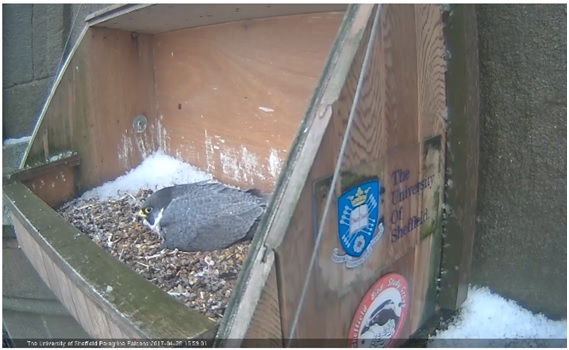Well, after a couple of trips away from Sheffield it’s good to see that all is going to plan with the Peregrines. A visit to St George’s this morning revealed the male sitting tight and the female on a nearby building and then on the E side of the church tower, out of sight of the webcams but very much present. She enjoyed a good preening session, making sure those feathers remain in tip-top condition.

Last week brought Esther Kettel to Sheffield Bird Study Group’s monthly indoor meeting. She delivered an excellent talk based on her PhD thesis, which explores how Peregrines are adapting to urban habitats and compares their situation with those in rural habitats. It was a really great evening with a lot to learn about these magnificent birds. Hopefully I’ll be able to give an update based on her talk some time soon, but in the meantime one of the standout facts for me was that urban pairs are more successful that rural pairs to the tune of one chick per clutch. When talking about four eggs/ chicks as a typical clutch/ brood, that’s a significant difference. The St George’s pair are part of her sample, and it’s great to know that they’re part of a wider success story.
The clutch of four eggs they are brooding is very much to be expected after four eggs every year since 2012 and has followed the pattern of the previous three years very closely, with the first egg laid on either March 19th or 20th and the fourth laid on either March 26th or 27th. So Easter Monday represents three weeks on from the completion of the clutch, with another 10 days or so until hatching might be expected. According to the previous few years’ schedule, reproduced below with this year’s laying dates included, my estimate is that hatching may take place on Friday April 28th, providing for an exciting close to the month.

In the meantime there will be a lot of sitting and occasional flurries of activity, but – hopefully – nothing too dramatic. Once the chicks have hatched, we can start to look at doing some of the things that the donations will support, such as DNA testing and colour ringing. It is humbling to see the donations that have come in to date, and we’re very grateful to everyone who has contributed to the cause. Do keep them coming!!








